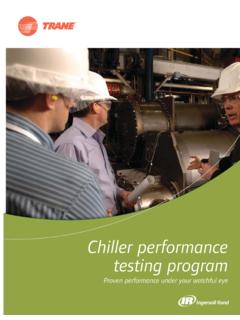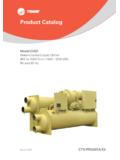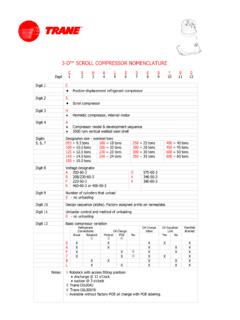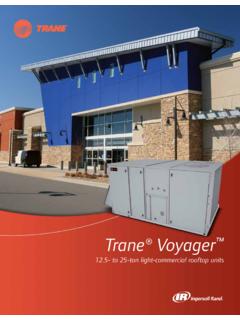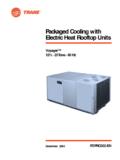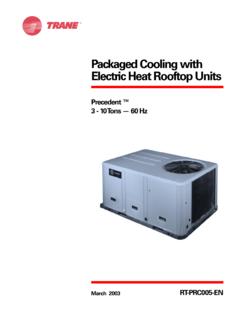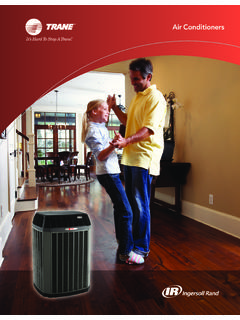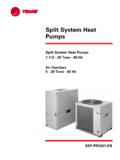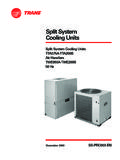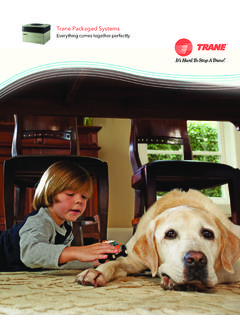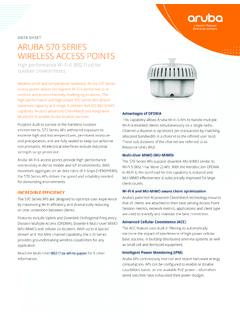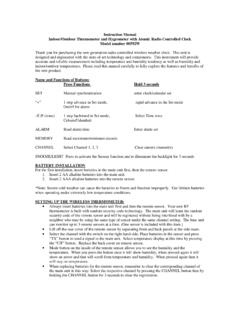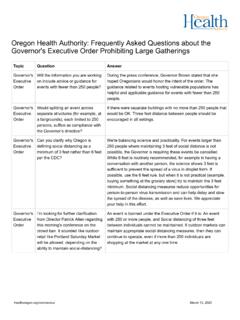Transcription of Managing Commercial Building Pressurization - Trane
1 Providing insights for today s hvac system designer 2002 American Standard Inc. All rights reservedVolume 31, No. 2 engineers newslettermanaging the ins and outs Building Pressurizationfrom the energy-efficient thermal comfort without adversely affecting indoor air quality or violating codes poses a considerable design challenge. Yet something as subtle as air movement through the Building envelope can determine whether an otherwise well-designed HVAC system performs EN reviews the importance of controlling Building pressure. It identifies the effects of indoor outdoor air pressures on Building performance, and then evaluates two common methods for directly controlling pressure in Commercial Pressure Matters in Commercial BuildingsUntreated outdoor air leaks into infiltrates the Building when indoor pressure is less than the pressure outside.
2 Control strategies typically strive to limit or eliminate infiltration as a means of minimizing HVAC loads and related operating costs. Infiltration isn t always bad, however. During the heating season, for example, a small amount of dry outdoor air leaking into the Building envelope discourages moisture from condensing excessively negative pressure causes problems. Uncomfortable drafts and stratification interfere with temperature control and may encourage odor migration. Outward-swinging doors become difficult to open, and inward-swinging doors fail to reclose, compromising amount of infiltration during the cooling season can raise the dew point within the Building envelope, which increases the likelihood of microbial growth and structural deterioration.
3 Infiltration of warm, moist air also affects occupied spaces by increasing latent indoor air leaks out of exfiltrates from the Building when the pressure inside is greater than the pressure the summer, exfiltration of cool, dehumidified indoor air benefits the Building by keeping the envelope dry. But excessively positive pressure makes opening and closing doors difficult and creates noisy high-velocity airflow around doors and windows. It can also wreak havoc with temperature control by impeding supply airflow into occupied the winter, even slightly positive pressure forces moist indoor air into the Building envelope. Moisture may Ducted or Plenum Return?
4 Ducting return air from a Building s occupied spaces back to the air handler increases the initial cost of the system, so why do it? Is it to meet local codes? Sometimes. Is it to facilitate return-path cleaning? Maybe. Is it to avoid moisture problems in the ceiling plenum? Probably not. To understand why, consider the following example ..Suppose that the pressure in the return air plenum must be approximately in. wg less than the pressure in the occupied space to overcome the return-grille pressure drop. If Building pressure is controlled to in. wg, then the plenum pressure will be + in. wg with respect to outdoors. This slight difference between the indoor and outdoor pressures will induce very little infiltration.
5 2 Trane Engineers Newsletter Vol. 31, No. 2condense on cold surfaces inside walls, hastening structural , the net pressure inside the Building relative to outside should range from slightly negative or neutral during cold weather (minimizing exfiltration) to slightly positive during warm weather (minimizing infiltration). Excessive Building pressure, whether negative or positive, should be thatAffect PressurePreventing extreme Building pressures is much easier said than done. In most structures, the indoor outdoor pressure difference results directly from the combined effect of weather, wind, and operation of the mechanical ventilation Like a column of water in a pipe, the weight of a column of air results in a head pressure that increases from the top of the column to the bottom.
6 Described as hydrostatic pressure, but more commonly known as stack pressure, the weight of the air column is affected by local barometric pressure, temperature, and humidity ratio. Temperature-related differences in indoor and outdoor air density create differences in pressure that can affect infiltration, exfiltration, and the direction of air movement within shafts and stairwells (Figure 1).When indoor air is warmer than outdoor air, the less dense column of air inside the Building results in a net negative pressure below the neutral pressure level (NPL) and a corresponding net positive pressure above it. Because all Building envelopes contain unavoidable cracks and openings, this pressure difference induces outdoor air to enter the lower floors and indoor air to leave the upper floors.
7 These leakage characteristics also encourage upward airflow normal stack effect within shafts and indoor air is cooler than outdoor air, the column of air inside the Building is more dense. The result is a net negative pressure at the top of the Building and a corresponding net positive pressure at the bottom. Unless Building pressure is controlled, outdoor air will infiltrate the upper floors while indoor air exfiltrates from the lower levels. The pressure difference also induces downward airflow in stairwells and shafts reverse stack 1. Stack effect and Building pressureSemantics of Building Pressure ControlTrue or False: Relief and exhaust are interchangeable descriptors for air removed from a it s true that both relief air and exhaust air leave the Building , their purposes (and definitions) airflow which may be central or local, constant or variable carries contaminants from the Building .
8 Local codes or industry standards define how much exhaust air must be removed from specific types of spaces (rest rooms, for example), regardless of pressure-related concerns or operating airflow removes air from the Building (again, either centrally or locally) to balance intake airflow and maintain proper Building airflow describes the rate at which the air handler brings air into the Building . Local codes or industry standards require a minimum amount of intake airflow for proper ventilation and to dilute and remove general contaminants. Additional outdoor air is brought into the Building during economizer operation to provide free the absence of infiltration and exfiltration, negative Building pressure results when exhaust-plus-relief airflow exceeds intake airflow.
9 Conversely, positive Building pressure results when exhaust-plus-relief airflow is less than intake airflow. providing insights for today s HVAC system designer 3 The 2001 ASHRAE Handbook Fundamentals provides an equation to quantify the stack-effect pressure difference:1where, ps= difference between indoor and outdoor stack pressures, in. wgC1= conversion factor, in. wg ft sec /lbm o= outdoor air density at outdoor air temperature, lbm/ft g= gravitational constant, ft/sec H= height above reference plane, ftHNPL= height of neutral-pressure plane above reference plane, ftTi= indoor air temperature, RTo= outdoor air temperature, RThe following example illustrates the magnitude of stack effect in a four-story, air-conditioned Building (H = 50 ft, Ti = 75 F = 535 R).
10 Assuming that cracks and openings are evenly distributed 1 American Society of Heating, Refrigerating, and Air-Conditioning Engineers, Inc., 2001, ASHRAE Handbook: Fundamentals (Atlanta, GA: ASHRAE), Equation 17. psC1 oToTi Ti----------------- gHNPLH () =throughout the Building envelope, the neutral pressure level exists at mid-height (HNPL = 25 ft).On a hot day (To = 95 F = 555 R, o= lbm/ ft ), the difference in indoor outdoor air densities produces a + in. wg pressure difference at the ground floor. Without Building pressure control, conditioned indoor air exfiltrates from the lower floors (H = 0 ft), keeping that part of the envelope dry.
